Hello future Clon-- Genetic Engineer, and welcome to the Aperture Science Genetic Engineering Course. Genetic Engineering is a risky and perilous project. Which is why we picked you to be the first test s-- Tester for this great prospect.
Part 1: Getting Started
Before you get into Genetic Engineering, we must create a Genetic Machine. This is the basis for all Genetic Engineering. Next, we must craft the Genepool. The Genepool takes your bees and breaks them down into Liquid DNA. When you place the bees in one of the left slots in the machine, like so:
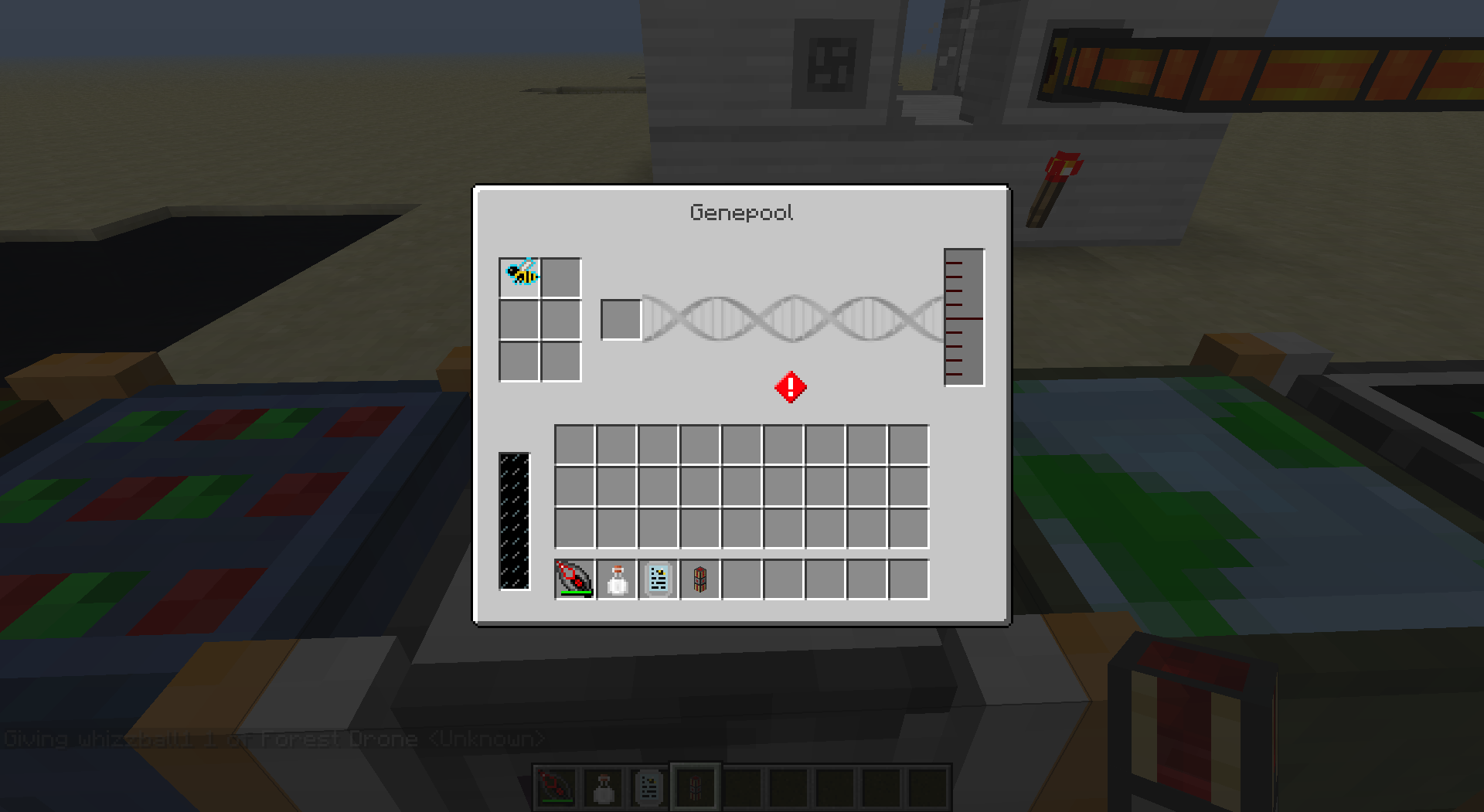
Please ignore the inherent sludge in the background.
Analyzed Bees will create more Liquid DNA, which is the main liquid used in Genetic Engineering.
Liquid DNA in tank:
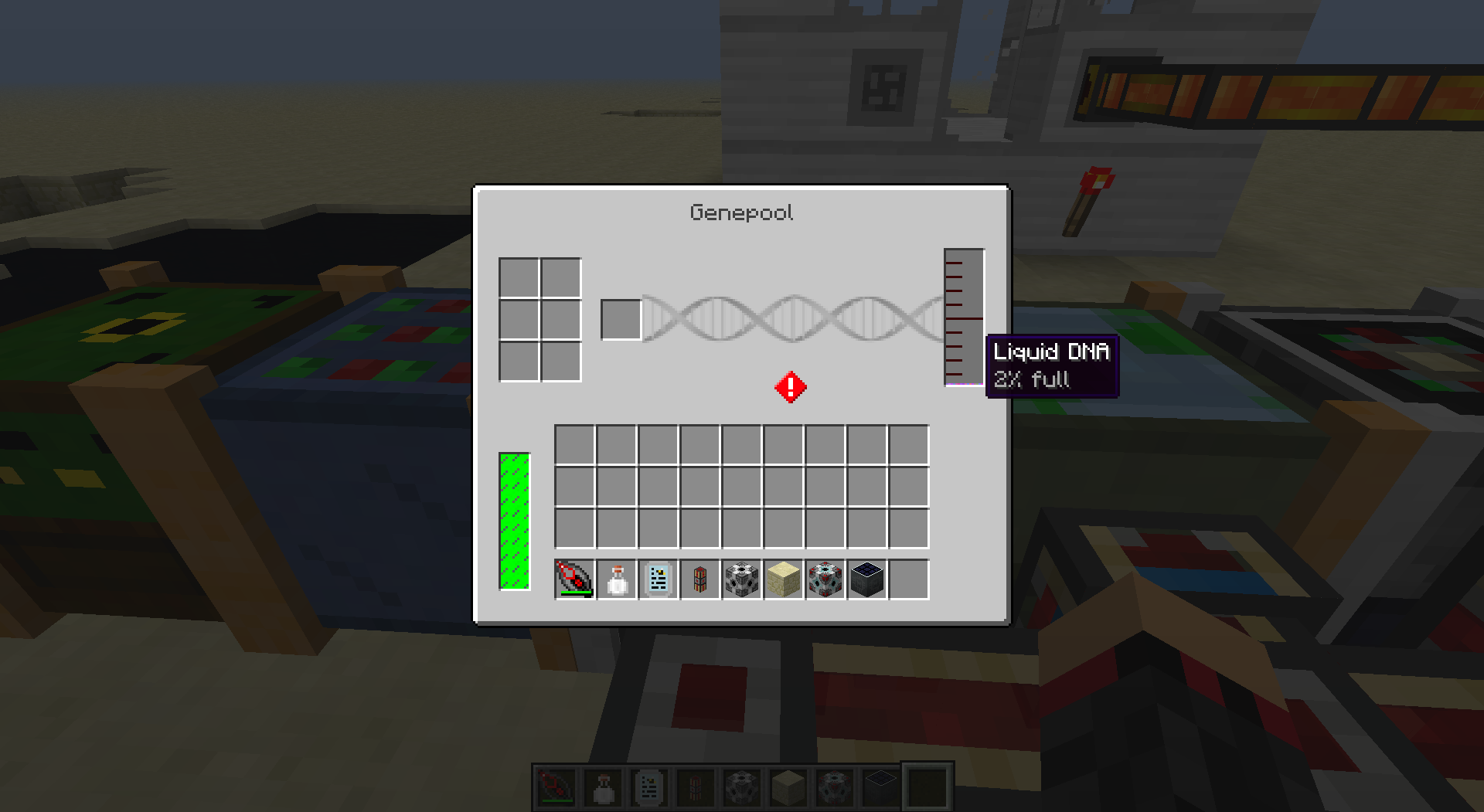
The DNA may be removed from the pool and placed in a tank.
The next block we need is the Indexer. This block stores bees infinitely. You will need it.
The final block is not as important, but very convenient: The Apiarist Databank. This will show default traits for every bee species you have ever bred. Stats include Humidity and Temp. Tolerance, Products, Climate, and various other things.
Part 2: Basic Genetic Engineering
Tier 1 (one) of Genetic Machines centers around mundane bees and also one very limited Genetic modifier.
The starting point for this would be the Acclimatiser. This object uses various objects to change the climate tolerance of a bee. The bee must be placed in the Globe, and the modifying object on the left slot. To give the bee Tolerance for colder climates, one must use Ice or Liquid Nitrogen. To give the bees Tolerance for Hotter Climates, apply Blaze Powder or Lava. To give the bees tolerance for Higher Humidities, use a Water Bucket. For Lower Humidities, use Sand.
Acclimatiser ready:
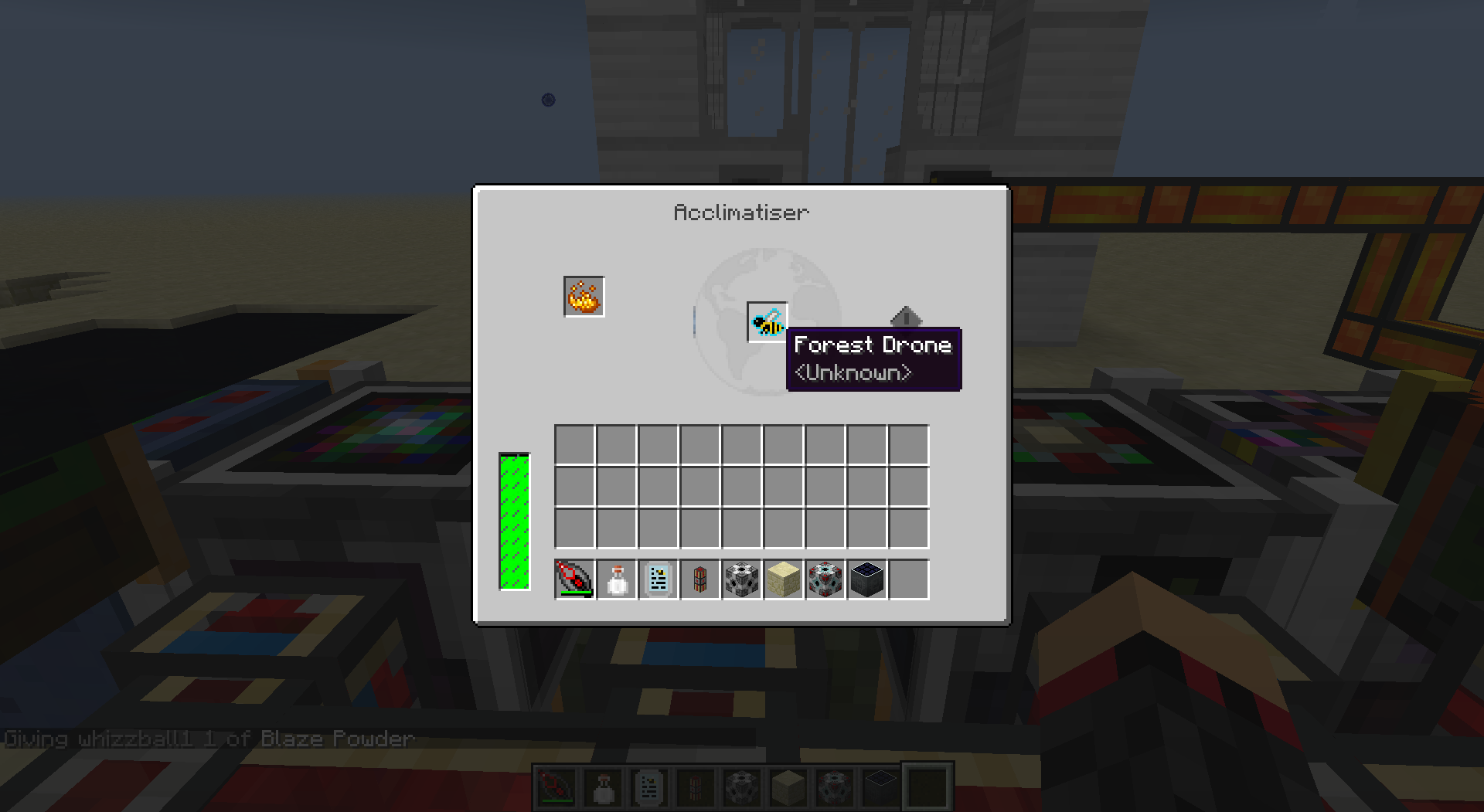
Partially done:

Do note that these next two machines are relatively useless unless you are very early game.
The next and more complicated machine is the Sequencer. Placing a bee in one of the left slots will begin the sequencing process. A Template must be placed in the bottom right slot. When the bee is done sequencing, the DNA on the right will begin to fill up. When it is completely filled up, you receive a filled template. Note that only bees with the same species will work until the sequencing is finished.
Bee in and partially done:
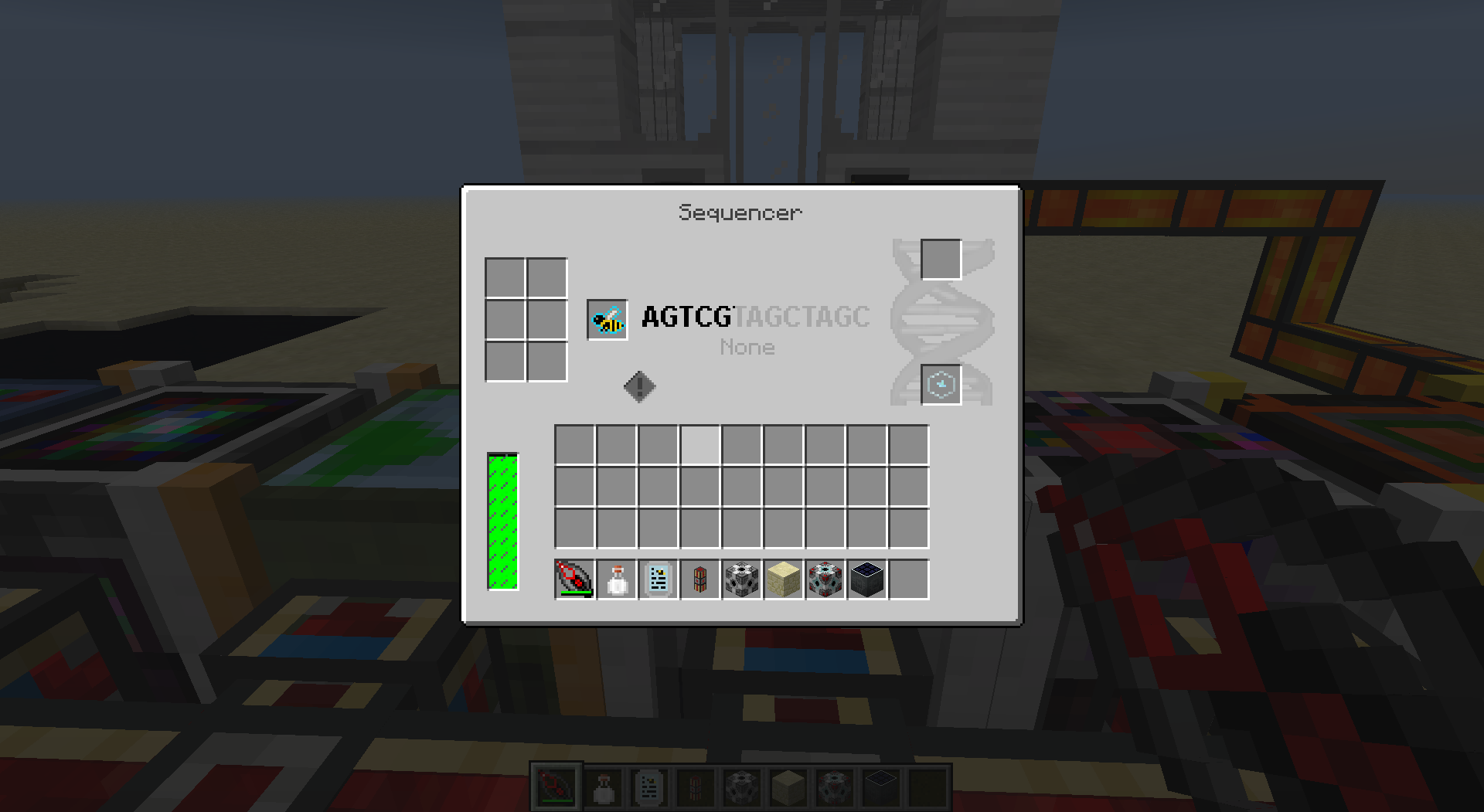
DNA Bar partially filled up:
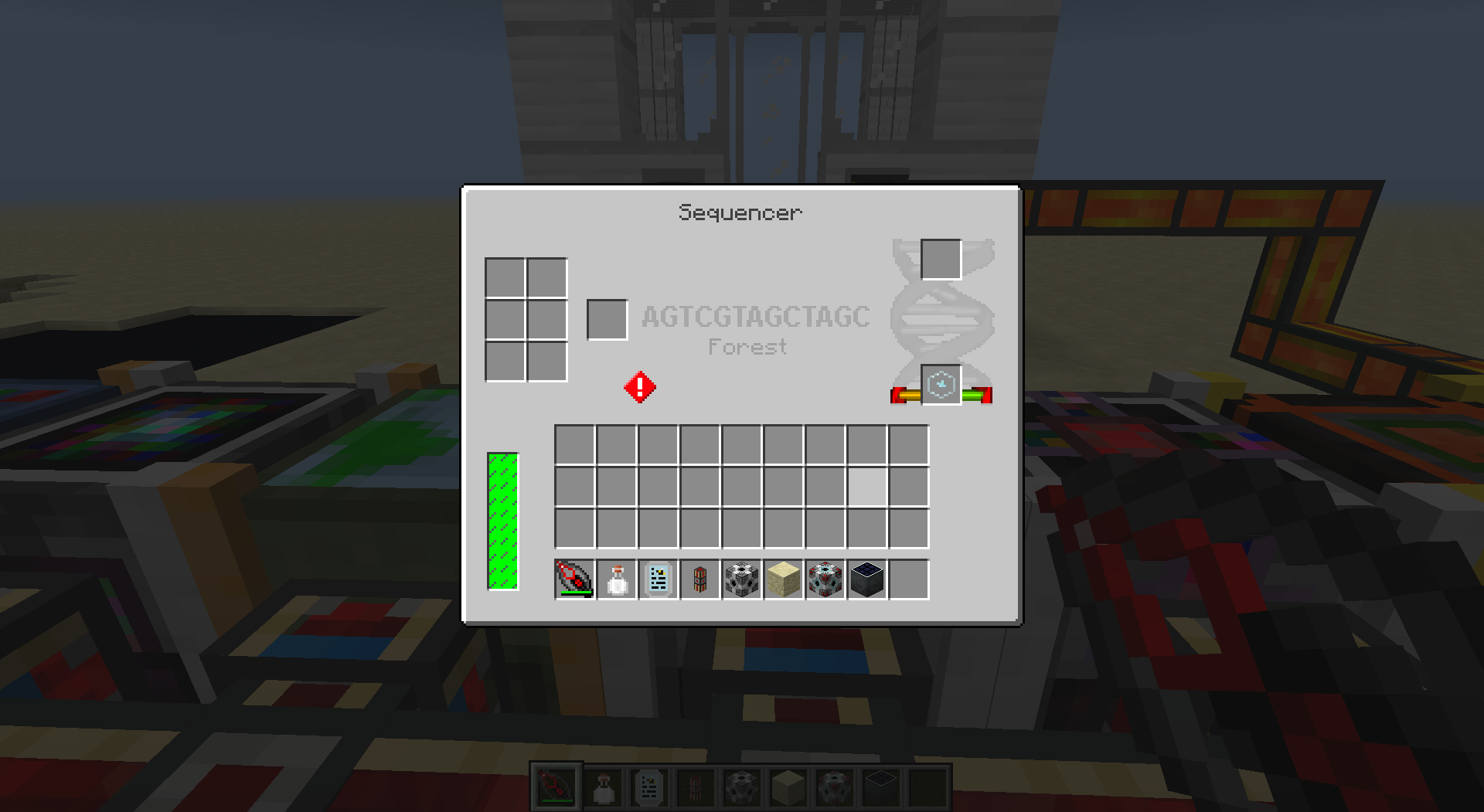
Do note, however, that if the template is removed whilst the DNA Bar is not filled up, then you will lose all progress.
Once you have this filled template, you may place it in the bottom middle slot of the Splicer. Then you can place a bee in one of the left slots and the species will slowly be added. This does require Liquid DNA. Do note, however, that this only works with Hive Bees and the Common species bee.
Part 3: Advanced Genetic Engineering
Tier 2 (two) of Genetic Machines centers around specific traits of bees, not just the species themselves.
Obviously, for Advanced Genetics, you need Advanced Machines, and therefore we will need to craft the Advanced Genetic Machine.
Do note that these machines and what to use them on do require Royal Jelly. You will have to get into some bee breeding to get into the Noble Branch. You will have to find your way towards the Imperial Bee. Some machines also require Emeralds and Ghast Tears. I would suggest getting these bees and objects early on.
The next machine we need is the Isolator. This isolates the specific traits in bees and creates Serums for them. By placing a bee in one of the Left slots and a Serum in the slot at the end of the chainlike structure. The bee will get a trait isolated. The trait will be placed in the serum. You may then remove the serum, and if you do not like the trait, you may smelt the serum to get a plain, untouched serum. Be careful! The bees have a default 30% chance of getting consumed in the process. Specific traits may not be made into serums, for example, a Bee not having Rain Tolerance, or not being Nocturnal, because these are technical traits, and not very useful.
The Replicator takes serums and duplicates them. Place a modified serum (A serum that has a trait added to it) in the left slot and an empty, plain serum in the right slot. This does take Quality from the serum.
Do note that this is also a relatively useless machine, unless you want to give your friends the serum also.
Quality determines the chance of a genetic error when giving a bee the serum.
Next, we need the Synthesizer. This takes your Modified Serums and fills them with Liquid DNA. This gives the Serums charge. However, this also takes Quality from the serums.
Now you may be asking how to Increase the quality of the serums. That is why you need the Purifier. This uses Liquid DNA to increase the quality of the Serum. To insure that there are no mistakes when you add the serum, please increase the quality until the Exclamation point inside the GUI is filled.
Finally, you need the Inoculator. This block applies the serum to your Bees. Place the Serum of any quality(However, Excellent Quality is recommended) in the left slot and the Bee you want to inoculate in one of the top slots. The object will slowly inoculate the bee. The Machine will randomly attempt to add the serum to either the active or inactive trait. The machine has a 100% chance to add the serum to either the inactive or active trait, but your bee will not finish until both have been inoculated. However, if the quality of the serum is not Excellent, there is a chance that a genetic mistake will occur. Genetic Mistakes include mistakes which make your bee unable to have a permanent family. This means that after a number of generations, your bee will die Permanently. Another mistake would reset the bee to the lowest traits, so tolerance will be reset to zero, workspeed will be set to slowest, life will be set to shortest, and so on. All this does depend on the quality of the serum. Do note, however, that when the machine attempts to inoculate a bee, one charge will be lost from the serum.
That is it for this guide on Genetic Engineering. Thank you for listening, and good luck future Clo- Genetic Engineer!
Part 1: Getting Started
Before you get into Genetic Engineering, we must create a Genetic Machine. This is the basis for all Genetic Engineering. Next, we must craft the Genepool. The Genepool takes your bees and breaks them down into Liquid DNA. When you place the bees in one of the left slots in the machine, like so:

Please ignore the inherent sludge in the background.
Analyzed Bees will create more Liquid DNA, which is the main liquid used in Genetic Engineering.
Liquid DNA in tank:

The DNA may be removed from the pool and placed in a tank.
The next block we need is the Indexer. This block stores bees infinitely. You will need it.
The final block is not as important, but very convenient: The Apiarist Databank. This will show default traits for every bee species you have ever bred. Stats include Humidity and Temp. Tolerance, Products, Climate, and various other things.
Part 2: Basic Genetic Engineering
Tier 1 (one) of Genetic Machines centers around mundane bees and also one very limited Genetic modifier.
The starting point for this would be the Acclimatiser. This object uses various objects to change the climate tolerance of a bee. The bee must be placed in the Globe, and the modifying object on the left slot. To give the bee Tolerance for colder climates, one must use Ice or Liquid Nitrogen. To give the bees Tolerance for Hotter Climates, apply Blaze Powder or Lava. To give the bees tolerance for Higher Humidities, use a Water Bucket. For Lower Humidities, use Sand.
Acclimatiser ready:

Partially done:

Do note that these next two machines are relatively useless unless you are very early game.
The next and more complicated machine is the Sequencer. Placing a bee in one of the left slots will begin the sequencing process. A Template must be placed in the bottom right slot. When the bee is done sequencing, the DNA on the right will begin to fill up. When it is completely filled up, you receive a filled template. Note that only bees with the same species will work until the sequencing is finished.
Bee in and partially done:

DNA Bar partially filled up:

Do note, however, that if the template is removed whilst the DNA Bar is not filled up, then you will lose all progress.
Once you have this filled template, you may place it in the bottom middle slot of the Splicer. Then you can place a bee in one of the left slots and the species will slowly be added. This does require Liquid DNA. Do note, however, that this only works with Hive Bees and the Common species bee.
Part 3: Advanced Genetic Engineering
Tier 2 (two) of Genetic Machines centers around specific traits of bees, not just the species themselves.
Obviously, for Advanced Genetics, you need Advanced Machines, and therefore we will need to craft the Advanced Genetic Machine.
Do note that these machines and what to use them on do require Royal Jelly. You will have to get into some bee breeding to get into the Noble Branch. You will have to find your way towards the Imperial Bee. Some machines also require Emeralds and Ghast Tears. I would suggest getting these bees and objects early on.
The next machine we need is the Isolator. This isolates the specific traits in bees and creates Serums for them. By placing a bee in one of the Left slots and a Serum in the slot at the end of the chainlike structure. The bee will get a trait isolated. The trait will be placed in the serum. You may then remove the serum, and if you do not like the trait, you may smelt the serum to get a plain, untouched serum. Be careful! The bees have a default 30% chance of getting consumed in the process. Specific traits may not be made into serums, for example, a Bee not having Rain Tolerance, or not being Nocturnal, because these are technical traits, and not very useful.
The Replicator takes serums and duplicates them. Place a modified serum (A serum that has a trait added to it) in the left slot and an empty, plain serum in the right slot. This does take Quality from the serum.
Do note that this is also a relatively useless machine, unless you want to give your friends the serum also.
Quality determines the chance of a genetic error when giving a bee the serum.
Next, we need the Synthesizer. This takes your Modified Serums and fills them with Liquid DNA. This gives the Serums charge. However, this also takes Quality from the serums.
Now you may be asking how to Increase the quality of the serums. That is why you need the Purifier. This uses Liquid DNA to increase the quality of the Serum. To insure that there are no mistakes when you add the serum, please increase the quality until the Exclamation point inside the GUI is filled.
Finally, you need the Inoculator. This block applies the serum to your Bees. Place the Serum of any quality(However, Excellent Quality is recommended) in the left slot and the Bee you want to inoculate in one of the top slots. The object will slowly inoculate the bee. The Machine will randomly attempt to add the serum to either the active or inactive trait. The machine has a 100% chance to add the serum to either the inactive or active trait, but your bee will not finish until both have been inoculated. However, if the quality of the serum is not Excellent, there is a chance that a genetic mistake will occur. Genetic Mistakes include mistakes which make your bee unable to have a permanent family. This means that after a number of generations, your bee will die Permanently. Another mistake would reset the bee to the lowest traits, so tolerance will be reset to zero, workspeed will be set to slowest, life will be set to shortest, and so on. All this does depend on the quality of the serum. Do note, however, that when the machine attempts to inoculate a bee, one charge will be lost from the serum.
That is it for this guide on Genetic Engineering. Thank you for listening, and good luck future Clo- Genetic Engineer!

